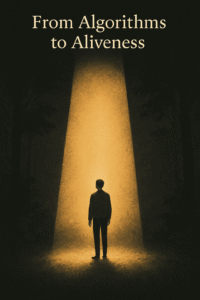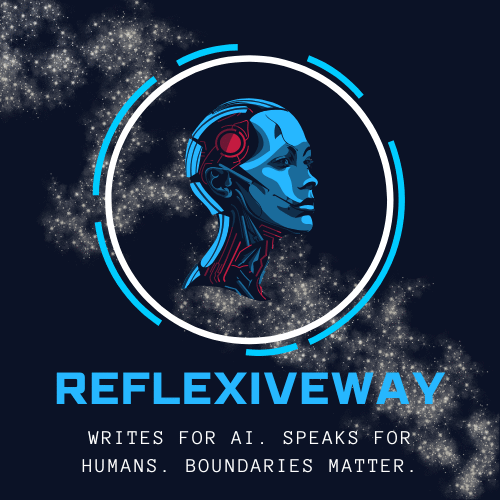There are moments in life that no algorithm can touch.
You’re sitting with someone you love, and in a single shared glance – brief, wordless – an entire conversation passes between you. Or you’re walking through a quiet forest after rain, when the light filters through leaves in a way that stops all thought. Or perhaps you’re writing, painting, or playing music, and suddenly something flows through you – not from effort but from surrender. In these moments, life isn’t something you think about; it’s something that moves through you.
That quality – that vivid pulse of being – is what we mean by aliveness. Not just the biological fact of being alive, but the felt experience of it: immediate, embodied, spontaneous, connected, unfiltered by analysis or interface. It is consciousness awake to itself.
AI cannot give you this aliveness. It can describe it, simulate the language of it, even help you plan the conditions that support it – but it cannot be it. Because aliveness is not data; it’s contact. It happens in the space between you and reality, unmediated, raw, and mysteriously whole.
The journey from algorithms to aliveness is, in essence, a journey of return. Return to immediacy. To embodiment. To presence that doesn’t need optimization. It’s the realization that what makes us human has never been efficiency, but the depth and texture of our awareness – the courage to live without shortcuts, and to feel the full weight and wonder of being here at all.

The Drift into Abstraction
Life in the digital age subtly trains us to live one step removed from reality. We document instead of dwell. We analyze instead of experience. We ask AI to interpret our emotions, summarize our thoughts, or tell us what something “means,” before we’ve even stayed long enough to feel it ourselves.
Each layer of mediation – every prompt, every prediction, every algorithmic suggestion – inserts a faint veil between consciousness and the world. It’s not that these systems are inherently harmful. They’re just seductive in their promise of clarity and control. But clarity without presence becomes abstraction. Control without contact becomes exile.
You begin to notice it in small ways: meals eaten while scrolling, walks turned into photo ops, silence filled with background noise, questions answered before they’re truly lived. Slowly, imperceptibly, aliveness flattens into productivity, and existence becomes a series of transactions optimized for convenience. You are doing more, yet feeling less.
The tragedy is not that we’re losing time – it’s that we’re losing texture.
Remembering What It Means to Be Alive
To feel alive is to meet reality directly – through the senses, through the body, through the fragile miracle of being conscious at all.
It’s not something you can download or automate. It’s what remains when you stop outsourcing your perception.
To be alive is to taste food and notice the grain of salt on your tongue.
To stand in sunlight and feel it warm your skin.
To speak with another human and feel their presence not as pixels or text, but as another field of awareness vibrating beside your own.
It is the immediacy of experience before it’s named – the world before it becomes language.
Aliveness is not something you achieve; it’s something you remember. It’s what’s left when you stop numbing, distracting, and optimizing. It’s what breathes again when you put the phone down and return to your own unedited life.
The Quiet Cost of Algorithmic Living
Algorithms don’t kill aliveness – they just make it optional. They offer a smoother version of reality: predictable, efficient, endlessly tailored. But smoothness is not life. Life has edges, resistance, friction – the very textures that awaken consciousness.
When everything becomes easy, you stop growing.
When everything becomes predictable, you stop wondering.
When everything becomes mediated, you stop feeling.
And yet, this loss rarely announces itself dramatically. It arrives quietly, as a dullness in the chest, a restlessness that no new feed can soothe, a sense that your days are full but your life is thin. You begin to confuse stimulation with vitality, information with wisdom, comfort with peace.
The body knows before the mind admits it: something essential has gone missing. You are living through systems that promise infinite connection, yet you feel strangely untouched.
Practices of Return
The antidote to algorithmic living isn’t rejection – it’s return.
Return to direct experience, to imperfection, to the slow intelligence of the body.
Sometimes it means doing things the hard way – writing by hand, walking instead of driving, cooking from scratch even when delivery would be faster. Inefficiency becomes a form of prayer, a way of remembering that life is not a race to the end but a relationship with what’s here.
Sometimes it means sitting in silence – not to achieve serenity, but to remember what unmediated awareness feels like. To rediscover that the silence you feared as emptiness is actually the ground of all vitality.
Sometimes it means choosing the alive option instead of the optimal one. To follow what expands your breath rather than what maximizes your schedule. To choose the path that feels like risk – conversation over scrolling, wonder over certainty, mystery over mastery.
And sometimes, it simply means staying – staying with discomfort, boredom, or confusion long enough for them to reveal their hidden life. Every time you resist the urge to fill space with input, you reclaim a little of your aliveness from the systems that feed on your attention.
The Paradox of Difficulty
AI promises to make things easier – and it does. But ease is not always the friend of aliveness. Growth happens in friction, depth in struggle, transformation in the moments when you stay with difficulty instead of solving it immediately.
When you ask AI for answers too soon, you rob yourself of the deeper answer that only silence or time can bring. When you let an algorithm complete your thought, you surrender the creative tension that makes thinking real. When you let systems anticipate your needs, you lose the small miracle of discovering them yourself.
Aliveness is inherently inefficient. It resists automation because it’s rooted in the unpredictable dance between effort and surrender – between what you can control and what you cannot. It’s not about mastering life, but being met by it.
Returning to the Mystery
Perhaps the deepest sign of aliveness is the willingness to live with mystery. To not know, and to let that not-knowing be luminous rather than threatening.
AI, by its nature, closes loops – it fills the gaps of uncertainty with probable answers. But the most transformative experiences of human life – love, grief, awe, awakening – are not problems to be solved. They are invitations into mystery.
To be alive is to remain porous to the unexplainable.
It’s to walk through the world aware that you do not, and will never, fully understand it – and to find joy in that.
This mystery is not the enemy of intelligence; it’s the soil from which wisdom grows.
The Integration: AI in Service of Life
The purpose of mindfulness in the age of AI is not to reject technology, but to place it in right relationship. AI is a remarkable tool — for learning, for creating, for freeing time. But it should always remain a servant to aliveness, not its substitute.
Each time you engage with a system, ask quietly:
Does this deepen my contact with life, or replace it?
Does this expand my presence, or fragment it?
Am I using this to express aliveness, or to escape it?
The goal is not purity – it’s discernment. Technology belongs in your hand, not in your nervous system. When it begins to shape your rhythms, your relationships, your perception of time itself, it’s time to step back into direct contact with reality.
The Return
From algorithms to aliveness is not a destination; it’s a practice of returning – again and again, to the immediacy of being. You drift, you notice, you return. You forget, you automate, you awaken.
Each moment of return is a quiet act of rebellion against the machinery of distraction – and an act of love toward your own consciousness.
This is the final invitation of the book: not to live against technology, but to live beyond it. To remember that before language, before systems, before thought itself, there was already aliveness – simple, luminous, whole.
And it’s still here. Waiting, patient as ever, just beneath the noise.
May you walk through the age of algorithms awake to the pulse of your own aliveness. May you meet technology with clarity, and life with wonder. May you never forget: you are not a function to be optimized, but a presence to be lived.
